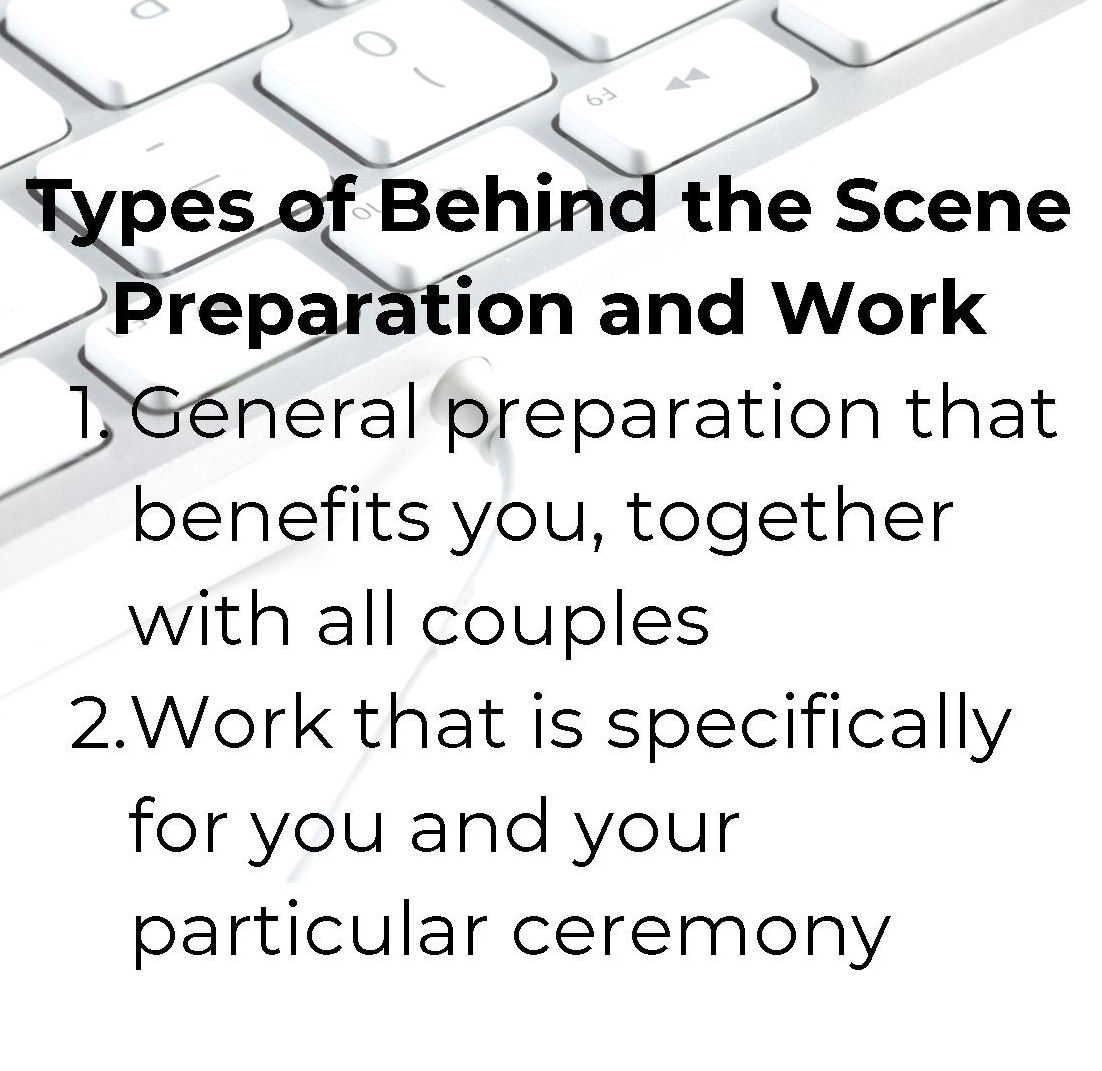Behind the Scenes: What goes on in preparing your ceremony
 It
is not unusual for a celebrant to receive a request
for a lowball fee on the grounds that "it is only an
hour". However, what you and your guests see on the
day is only a fraction of what I do to make your
ceremony special and your marriage legal. An
incredible amount of work and preparation happens
behind the scenes to make that hour possible. It is
also not unusual for full realisation of how much
behind the scenes preparation is involved to sink in
only when a couple attends other weddings down the
track and sees the result of some of that behind the
scenes work being omitted. Here's an example:
It
is not unusual for a celebrant to receive a request
for a lowball fee on the grounds that "it is only an
hour". However, what you and your guests see on the
day is only a fraction of what I do to make your
ceremony special and your marriage legal. An
incredible amount of work and preparation happens
behind the scenes to make that hour possible. It is
also not unusual for full realisation of how much
behind the scenes preparation is involved to sink in
only when a couple attends other weddings down the
track and sees the result of some of that behind the
scenes work being omitted. Here's an example:"Hi Jenny,
We both went to a wedding last night and I felt compelled to write to you today. Last night's ceremony was nice however I couldn't help but notice the celebrant lacked the attention to detail which you had. Throughout the ceremony I wondered if she considered the following:
- her dress choice - which was red, purple, orange and yellow, low cut and bright.
- the music - which was cut off mid-song when the bride arrived.
- the PA system - there wasn't one. It was an outside ceremony and I missed some of it because I couldn't hear her.
- the pink lacy bra she was wearing which we could see, in all its glory, when she bent forward to light the candle;
- did she consider the cheap fluro pink plastic folder she had her documents in?
- did she consider where she was standing - I couldn't get a good photo of the bride and groom because she was in the way!
- the ceremony content - I left the ceremony thinking.. Where did they meet? How did they meet? who are the people in their bridal party?
I don't mean to be disrespectful to the celebrant of last night's wedding. Unfortunately for yesterday's wedding service, all these minor things added and I walked away dissatisfied with the service. I didn't think about these small things when booking your services and I certainly didn't think to ask about them... but I sure am glad you paid attention to detail. Yesterday's wedding has highlighted the standard of professionalism we got from you leading up to and during our wedding day - it was the best service we could have imagined. Our guests commented on how personalised our service was and even commented on your emotive responses on the day. I am so pleased they remember you for all the right things. Although I sent you a 'thank you' card after our wedding day I just felt compelled to write to you and say thank you again Jenny. I wonder if I'll ever go to another wedding ceremony and actually see a celebrant who has paid attention to every little detail like you. You helped to make our day memorable and you've set the standard high. Regards, Melissa "
There are Two Types of Behind the Scene Preparation and Work : General preparation that benefits you, together with all of my clients, and work that is specific to your particular ceremony
General Preparation that benefits all of my clients
As a Ceremonialist, my role is to create individual ceremonies that reflect the vision, personalities, and wishes of each couple. But to be able to do that effectively requires a knowledge of the history of marriage ceremonies, of the traditional marriage ceremony (in order to understand what can and should be observed and what can and should be either omitted or adapted to fit 21st century sensibility in relation to gender stereotypes and the nature of marriage and relationships), and, very important, where custom, tradition, and legal requirements intersect and interact. (I give you my booklet entitled Designing Your Ceremony - but it is not about choosing pre-written sections of a ceremony, it is about all the choices you have about how and why it doesn't have to be all about the celebrant!). While I have shared quite a lot of my knowledge and perspective on various aspects of the ceremony through my published books, I draw on this knowledge, together with ongoing reading, thinking, and research to make suggestions specific to each couple.
And then, there is general mindfulness - all the thinking and researching that goes into answering the "What if...?" questions and putting into place processes to make sure that those things don't happen. Melissa covered a lot of that in her message above. Much of it comes down to making sure that your ceremony is choreographed and performed in such a way to facilitate your photographer and videographer getting the best images possible images where no-one is blocking the line of sight to the couple, the celebrant's clothing or equipment doesn't draw the eye in the photographs (there is a reason for the "touch of red" rule in photography, and you don't want that.) This includes making sure my wardrobe contains understated outfits that won't be a talking point! But it also includes both the willingness and the capacity to work with other wedding service providers as a team on the day.
And finally, the first "contact" most couples have with me is through reading one of my websites and/or Face book pages. You only have to look at them to see the huge amount of work that goes into them on an ongoing basis.
Work specific to your particular ceremony
- Communication
From first phone call, email, or Face book message, through our first meeting (which can run for 1.5 to 2 hours and involves completing the Notice of Intended Marriage and sighting your documents and noting their details on the Notice, together with discussing ideas and options for your ceremony), the process of developing and refining the ceremony to follow-up afterwards, we will be communicating just as much as you wish or need. - The Legal requirements
As mentioned above, plus ensuring that your marriage ceremony ticks all the legal boxes - Information gathering and absorbing
This is done through conversations and emails but primarily through questionnaires - Research
Where you want to celebrate a particular heritage, convey particular message, or accommodate unusual layout dictated by the ceremony space, some research may be needed. - Designing and Writing the Ceremony
In just the same way a building is designed before it is built, so is your ceremony designed before it is written - so decisions about who will be involved, how you will enter and move about the ceremony space, what ceremonial elements will be included, plus additions such as music are made before the work of writing the ceremony commences. - Formatting and printing
The certificates you sign on the day, my reading copy, your keepsake, and any readings all have to be formatted and printed. I also print copies of the information booklets I give you at our first meeting, copies of forms you need, and relationship information for you to keep. - On the day there could well be some saving-the-day on-the-run problem-solving that you won't be aware of unless someone tells you after the fact
- Travel to the venue and setting up
Usually done and dusted before most of the guests have even arrived
- Post ceremony Paperwork
After your marriage all paperwork needs to be checked, details of where and when the marriage took place noted on the Notice, and all paperwork scanned and forwarded to Births, Deaths, and Marriages for registration of your marriage.
All of the above Behind the Scenes work can make the
hour on the day look effortless! Trust me, a lot
of effort goes into giving that impression.
But there is also a third thing that often only
becomes evident in hindsight - and that is everything
your celebrant brings to the table. When we go to a
doctor, or a lawyer, or an accountant, we are very
aware that we are paying not just for their time, but
for their knowledge and skills, gained through
education, training, and hands-on experience. And we
look for the most knowledgeable, most skilled, because
we know that that helps ensure a good outcome. Same
with your celebrant. So a good part of the behind the
scenes work doesn't show in hours spent, but in the
knowledge and skills your celebrant brings to those
hours.
